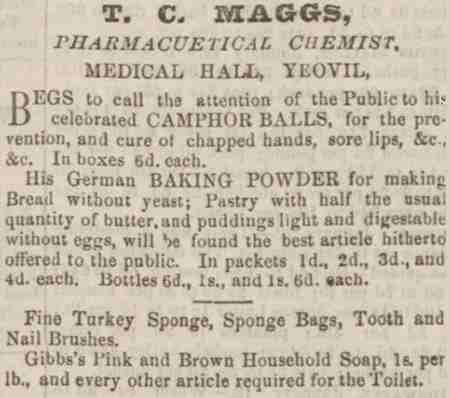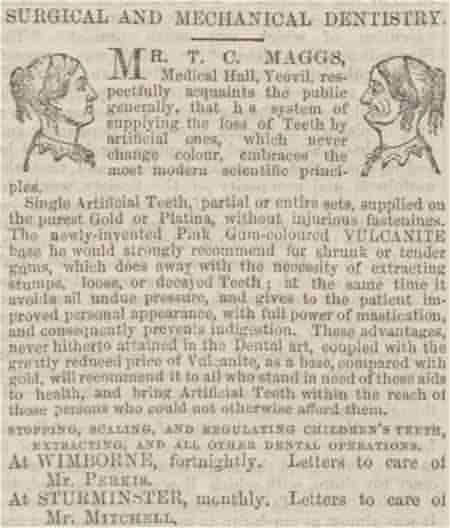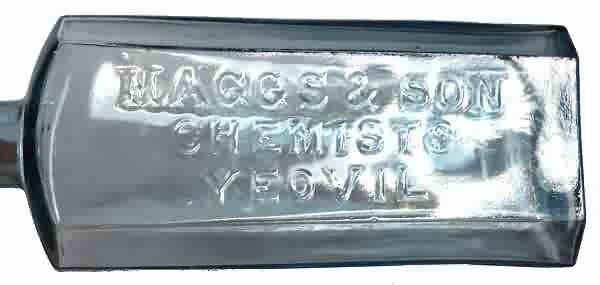Yeovil People
thomas charles maggs
Chemist and Fellow of the Geological Society
Thomas Charles Maggs was born on 13 March 1824 in London, the son of servant Thomas Charles Maggs Snr and his wife Martha, and was baptised on 23 April 1824 at St Marylebone. Little is known of his early life but in September 1845 at Bath, Somerset, at the age of 21, he married Charlotte Bussell of Bath, daughter of John and Sarah Bussell. Thomas and Charlotte were to have nine children; Catherine Marion 'Kate' (1847-1916), Amelia Charlotte (1849-1887), Elizabeth Martha Dunlop (b 1851), Henry Mortimer (b 1852), Frederick Richard (1854-1937, Dental Surgeon), William Adolphus (1856-1941, Physician & Surgeon), Alfred Charles (b 1857), Edward John Quintus (1864-1927, Solicitor of Hanover Square, London) and Eleanora Beatrice (b 1867).
By the time of the 1851 census, Thomas and Charlotte were living in the small village of Kelvedon, Essex, with their two daughters Catherine and Amelia together with a domestic servant. Thomas gave his occupation as 'Chemist & Druggist'.
By 1855, Thomas had moved his family to Yeovil, and in the 1861 census 35-year old chemist and druggist Thomas was in residence at the Medical Hall in the Borough with his wife Charlotte, their seven young children, an assistant, two apprentices, two house servants (18-year old twin sisters Eliza and Matilda Bartlett) and an errand boy.
It would appear that in 1860 Thomas Maggs' rebuilt the Medical Hall, especially after he branched out into dentistry. By 1871, Thomas, now aged 47, was describing himself as a pharmacist and dentist. Charlotte and seven of the children were living with him and two of the sons, 16-year old Frederick and 15-year old William, were listed in the census as chemist's assistants. There was also a pupil pharmacist, presumably an apprentice.
 Thomas
Maggs used the
windows of the
Medical Hall to
exhibit various
fossils and
skeletons he had
collected. These
were displayed
below an array
of
brightly-coloured
chemist's jars -
the insignia of
his trade. The
Western Gazette
carried a series
of letters in
the 1930s in
which people
recalled earlier
Yeovil and one
correspondent
remembered
seeing the
skeletons of a
cat and a rat
displayed in
Maggs' window
which had been
found during the
demolition of
the "old
dressing yard
carried on in
Foot's Yard".
Apparently, it
was claimed,
that the cat had
chased a rat
deep into the
foundations but
the hole became
narrower and
narrower and
eventually both
rat and cat
died.
Thomas
Maggs used the
windows of the
Medical Hall to
exhibit various
fossils and
skeletons he had
collected. These
were displayed
below an array
of
brightly-coloured
chemist's jars -
the insignia of
his trade. The
Western Gazette
carried a series
of letters in
the 1930s in
which people
recalled earlier
Yeovil and one
correspondent
remembered
seeing the
skeletons of a
cat and a rat
displayed in
Maggs' window
which had been
found during the
demolition of
the "old
dressing yard
carried on in
Foot's Yard".
Apparently, it
was claimed,
that the cat had
chased a rat
deep into the
foundations but
the hole became
narrower and
narrower and
eventually both
rat and cat
died.
In fact, Thomas had amassed a fine collection of fossils by 1871 when it was visited, and warmly commended, by a party of the Geologists Association of London. Exhibits from Thomas' fine collection of fossils were ultimately dispersed and specimens were to be found, among other places, in the Somerset County Museum, the Dorset County Museum and the Sherborne School Museum. It would appear that Thomas sold much of his collection to Robert Damon, the famous fossil dealer of Weymouth.
In 1875, Thomas became inextricably linked to the death of Henry Turberville, the eccentric 51-year old brother of the Victorian author Richard Doddridge Blackmore, author of Lorna Doone. Henry had made several wills, the last of which named Thomas as his sole executor and willed his estate to the Maggs family after having fallen in love with Thomas' daughter Elizabeth, at the time aged 23. While staying at the Three Choughs Hotel, Henry had become "fascinated by a fair Yeovilian while staying at the hotel." He had proposed to her and made out a new will, leaving something like £19,000 (approaching £12.5 million at today's value) to her and her family. A court case ensued, brought on by Blackmore who believed Thomas had murdered his brother by administering drugs. Blackmore lost the case, but the solicitors involved (there were more parties involved than just Blackmore and Maggs) agreed a settlement in which Blackmore received £2,000 and Thomas and his family received £15,000.
In the 1881 census, Thomas described his occupation as 'Pharmaceutical Chemist and Dentist'. Charlotte was still with him as well as daughter Catherine. Son Frederick was also describing his occupation as a Pharmaceutical Chemist and Dentist. In addition there were in residence a dental assistant, a chemist's assistant, two chemist's pupils, a cook and a housemaid.
In 1883, Thomas was elected a Fellow of the Geological Society, but sadly on 26 January the following year Charlotte died, aged 59. Shortly after her death Thomas moved to 56 Clarendon Villas, Hove, Sussex, where he lived alone with a servant. In the 1891 census, 67-year old Thomas described his occupation as 'Living on Own Means'. He died on 26 July 1900 at 2 Cardigan Gate, Richmond Hill, Surrey.
On 3 August 1900, the Western Gazette carried Thomas' obituary - "The sudden death of Mr TC Maggs, a former resident of this town, occurred on Thursday July 26th at Richmond Hill, Surrey, the cause being apoplexy. The deceased gentleman, who it will be remembered, left Yeovil 16 years ago to reside at Brighton, was well known in this town and neighbourhood as an ardent geologist, his collection of fossils being one of the best in the West of England. He also took an active interest in scientific subjects, was a Member of the British Association, and a Fellow of the Geological Society...."
Thomas' will was proved in October 1900 by his sons Frederick and William and his estate was valued at £7,908 17s 1d (around £4.3 million at today's value).
gallery

Thomas Maggs' advertisement in the 23 January 1855 edition of the Sherborne Mercury.

Thomas' advertisement in the 17 April 1855 edition of the Sherborne Mercury. Note that Maggs took over the Medical Hall following Tytherleigh.

Thomas' advertisement in the 19 May 1857 edition of the Sherborne Mercury, in which he notes his former employer Messrs Dinneford & Co, Bond Street, London.

... and this from the 29 September 1857 edition of the Sherborne Mercury.

An advertisement in the 25 June 1864 edition of the Western Gazette extolling the virtues of Thomas Maggs' 'Surgical and Mechanical Dentistry'.

This early photograph dates to about 1865 and looks towards the Borough from High Street with the end of Middle Street at centre. The three-storey building to right of centre was Thomas Maggs' pharmacy and dental surgery, named the Medical Hall. Maggs had rebuilt the Medical Hall in 1860

Courtesy of Tony
Rendell
A medicine bottle used by Thomas Maggs during the latter half of the nineteenth century.